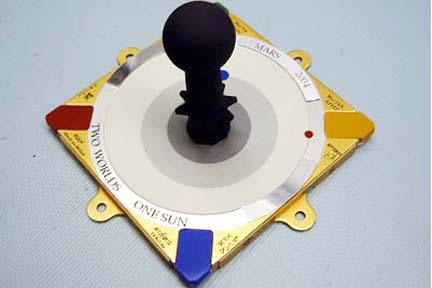
COURTESY PHOTO
A sundial, pictured at top, used on the Mars rover was designed by Jon Lomberg, of the Big Island. The dials feature the Hawaiian word "hokuula," or "red star."
Isle artist adds
local touch to
Mars craftJon Lomberg helps design a
sundial for the Mars rover Spirit
Tacked onto a rear panel of the robotic rover that is hurtling toward Mars today is one of astronomy's oldest instruments, a sundial, featuring the flair of a Big Island artist and the Hawaiian word "hokuula," or "red star."
The 3-inch-square plate, with an upright post in its center, has a vital mission as a color patch to calibrate the rover's panoramic camera, but it will also allow children on Earth to mark Martian time.
Local Mars exhibits
Bishop Museum will showcase images captured by the camera aboard the Mars rover Spirit if the landing goes as planned. A staff member will be available in the planetarium from 9 a.m. to 4 p.m. tomorrow to help interpret them. The planetarium show "The Red Planet Mars" takes place at 1 p.m. daily.The Onizuka Space Center at Kona International Airport has an interactive exhibit on the Mars Exploration Rovers Mission that features NASA video, Martian globes and models of the rocket and the rover.
"The rover is a very high-tech piece of hardware, and it's nice to think that something as simple as just a stick and a shadow will tell you where and when you are in the world -- or on Mars," said Jon Lomberg, an astronomical artist who lives in Honaunau and helped design the device.
Spirit, one of NASA's Mars Exploration Rovers, was launched June 10 and is scheduled to plunge into the red planet's atmosphere and land tonight in Gusev Crater, where it will search for signs of water or life. A duplicate sundial is mounted on the rover's twin, Opportunity, which is scheduled to land Jan. 24.
Lomberg joined a team of scientists in creating the sundial as part of the mission's educational effort. The motto, "Mars 2004, Two Worlds, One Sun," runs along its circular bands, which represent the orbits of Mars and Earth. The word for Mars in 16 other languages mark its four sides, with varied scripts including Chinese, Inuktitut and ancient Mayan, whose culture valued Mars.
"These kinds of explorations are done on behalf of all humanity," Lomberg said yesterday. "One good way of symbolizing that is to put the name of Mars in as many languages as we could fit on it."
He added: "The image of this little sundial will be beamed back at least once a day to make sure the cameras are set properly, and be put on the Internet. By looking at the shadow cast on the sundial, our kids could work out where the rover is on Mars and what time of day it was."
A Martian day is almost the same length as Earth's, and a Martian year runs roughly twice as long as Earth's. The Martian sundial has no hour marks because the rover will be moving around; the lines will be added electronically onto photos of the sundial.
No space is wasted on the device. Its edges, just an eighth of an inch high, are etched with drawings from children from across the country, including Lomberg's son Jonathan and daughter Merav, and a message to any Martian explorers that might follow. It reads in part:
"We used this post and these patterns to adjust our cameras and as a sundial to reckon the passage of time. The drawings and words represent the people of Earth. We sent this craft in peace to learn of Mars' past and to prepare for our future. To those who visit here, we wish a safe journey and the joy of discovery."
For more information on the sundial, visit athena.cornell.edu/kids/sundial.html. To learn more about the Mars mission, see marsrovers.jpl.nasa.gov/home/index.html. Jon Lomberg's Web site is www.jonlomberg.com
